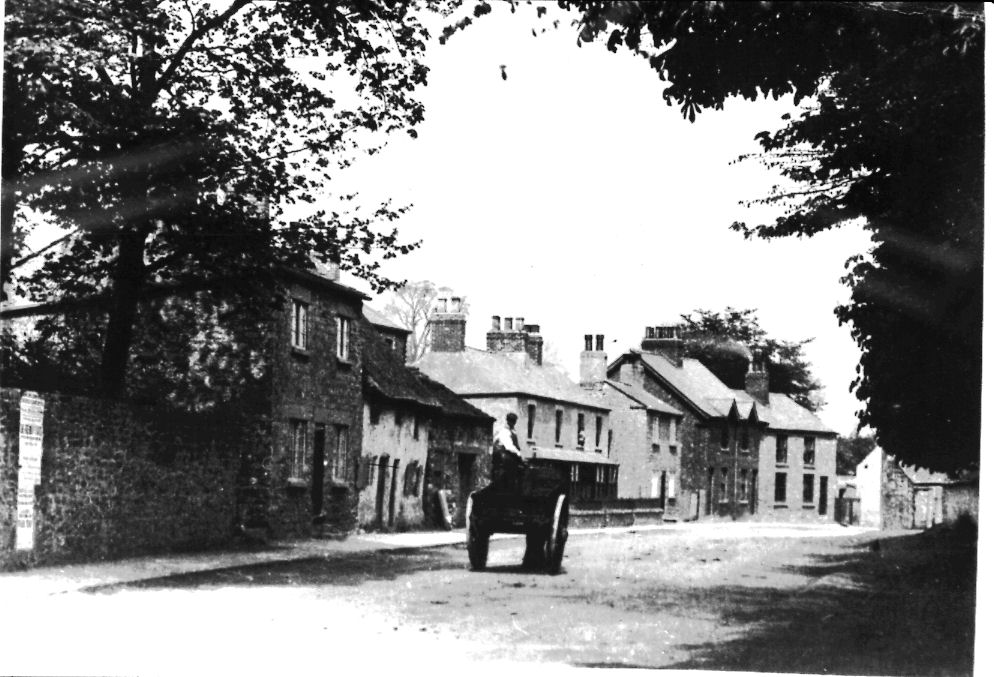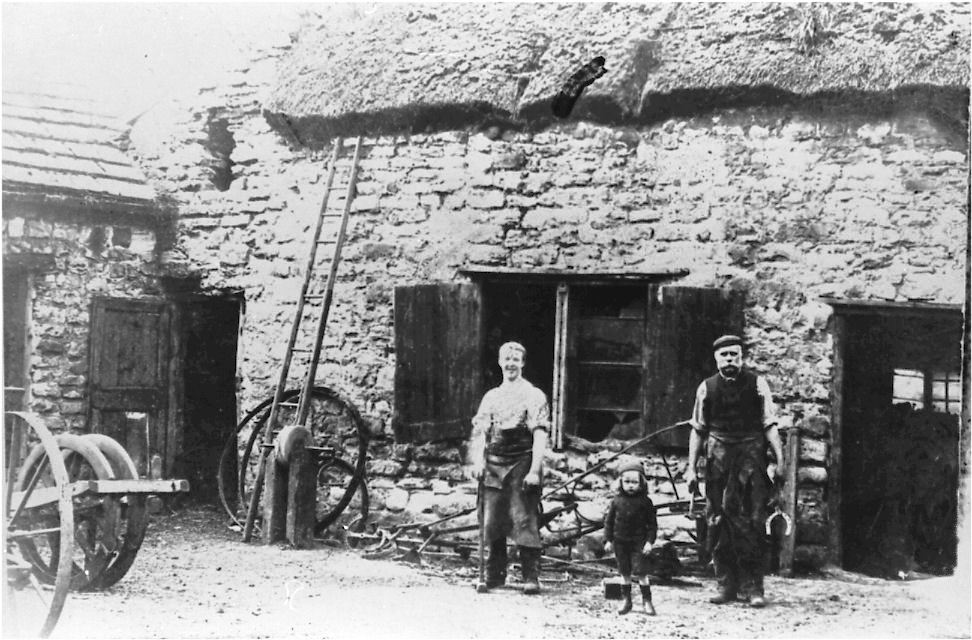
Scene of Main Street showing the Smithy and the Attic Abode on the left
|
"BLACKSMITH OF 76. The Oldest in Yorkshire" "Who is the oldest working blacksmith in Yorkshire? At the age of 76, Mr Willam Richard Collett of Barwick-in-Elmet, can lay claim to the title, for he still does every kind of blacksmith's work, including shoeing horses. He carries on the business founded by his great-great-grandfather, and is very proud of the fact that his family has lived in Barwick longer than any other. He and his wife and two daughters live in a stone-built house which was built by his great-great-grandfather and which is over two hundred years old. At one time the village blacksmith combined the duties of doctor and horse-doctor as well, and in the kitchen there are still the various medicines for the blacksmith's human patients. His veterinary medicines were kept in similar drawers in the smithy. Mr Collett remembers his grandfather being called in to stitch the head of a woman who had had a heated argument with her husband. When Mr Collett was speaking about the incident his wife broke in laughingly, 'I bet he stitched it with a rusty needle and a piece of tar-band!' In his youth Mr Collett had a great reputation as a runner and walker. The hardest work he ever did was when he and his brother made and fitted 68 shoes. There had been a heavy fall of snow on the previous night and an unusual number of horses had to be shod. Another interesting point about Mr Collett's family is that the first iron harrow used in the Barwick district was made by his grandfather from a model he saw at the Great Yorkshire Show. Due to a shooting accident, in which he lost the use of the toes of his left foot, Mr Collett cannot move about so quickly but still is able to do every job a blacksmith is supposed to do. In these days of motor transport he does not have to shoe as many horses as he did previously but he still does all that come to him." |
|
""THE BLACKSMITH OF BARWICK" "A Family Tradition and a Look at Other Days" " "Barwick-in-Elmet , where the Maypole stands, is the obvious place for a Village blacksmith of ancient descent, and William Collett, now 74 years of age, represents the fifth generation of blacksmiths of that name in this picturesque spot, near Leeds. But even with the heyday of shoeing to look back upon, and a craft handed down to him from great-great grandfather's time, it is not particularly upon horse-shoeing that Mr Collett looks back for his liveliest reminiscences. Rather do these concern the time when a colony of Leeds artists and writers made Barwick their weekend and holiday home, in two old thatched cottages, one called Ye Attic Abode and the other The Drop Inn. These two cottages have long been done away with and most of the other thatched roofs in the village have gone but it is still easy to see why Barwick should been appealed to these young fellows of lively mind and artistic bent. Lying away from the main roads, it is typical of the English scene. Its trees are of great beauty, it retains its old world air and it has friendly inns. Ernest Forbes was a particularly lively member of a very lively party, and others in the colony were W Alban Jones, the architect; the late JT Friedensen, black and white artist; 'Kester'; Oliver Onions, the novelist; Ospovat, the most brilliant of them all, who died young, but some of whose work has been secured by the British Museum: and Edmund Bogg, with his great stride, writing his guides to the Yorkshire Dales; he must smile now at all this new 'pother' about hiking, as if men had never trusted to their two legs before. 'Sometimes they had no money, and sometimes they had,' says Mr Collett. 'They were lively lads. They locked Mr Jones in a cubby hole and left him, and we had to let him out, but he got his own back by stealing their clothes in the night.' These young chaps painted their cartoons on the doors and old-fashioned shutters, both sides, but when the cottages were pulled down, somebody cleaned and repainted the doors for another purpose, and has bemoaned the fact ever since. They made Berwick a lively place. 'And no doubt they've all settled down now,' says Mr Collett. Ye Attic Abode adjoined Mr Collett's smithy . There are not the horses to shoe now that there were, and there are no joiners in Barwick now to build carts and wagons, though there were three once, with all the work they could cope with. Before they could inherit the family smithy, Mr Collett and his father had both in their turn to turn out and work the smithy at Potterton. It was here that Mr Collett's father used to send to him the awkward horses which he was too old to manage himself, and Mr Collett used to throw them to the ground on the green turf behind the smithy, rope their legs and then shoe them. Mr Collett never shod cattle, but he still has some of the thin, peculiarly-shaped plates which were used by his father and grandfather for that purpose. And as for the Maypole, and Barwick Feast Sunday, Mr Collett recalls that these events more far more liveliness than they do now - or at least it seems they did. Certainly there isn't the great roasting of beef on jacks before the fire, with the Yorkshire pudding underneath to catch the drippings, that was the way of tbings on Barwick Feast Sunday long ago. Barwick then used to be so crowded with people and gigs and wagonettes, that the Vicar had 'all on' to make his way to the church." |

 |
This picture, from a post card with a postmark dated September 1909 shows Bill Collett outside the thatched blacksmith's shop with his assistant Sidney Plews, who married one of Bill's daughter's, Sally, and later went to live in Collingham. Sidney's son Laur1e still lives there. The smaller 'helper' is my father Leslie aged about five at the time. |